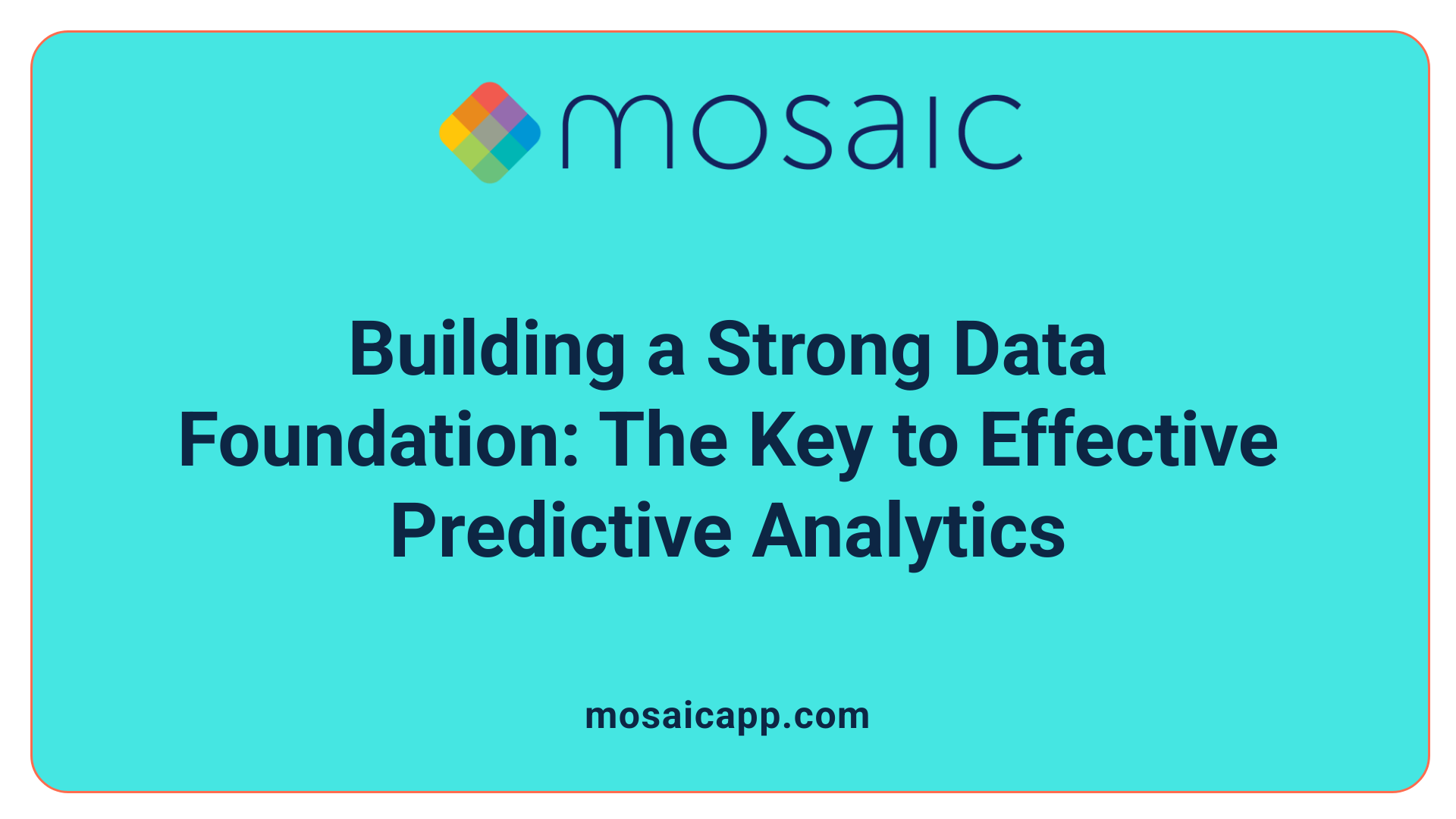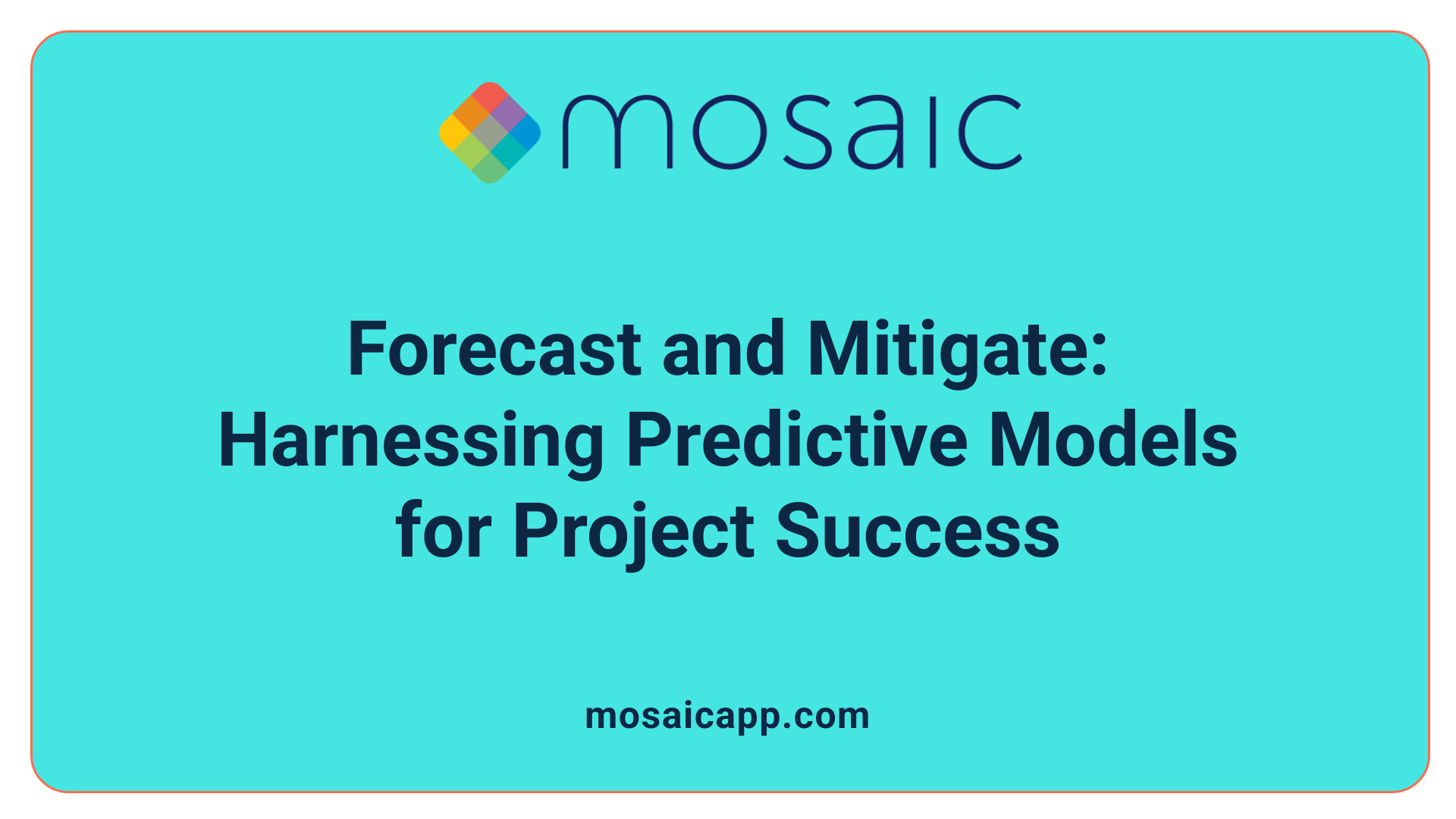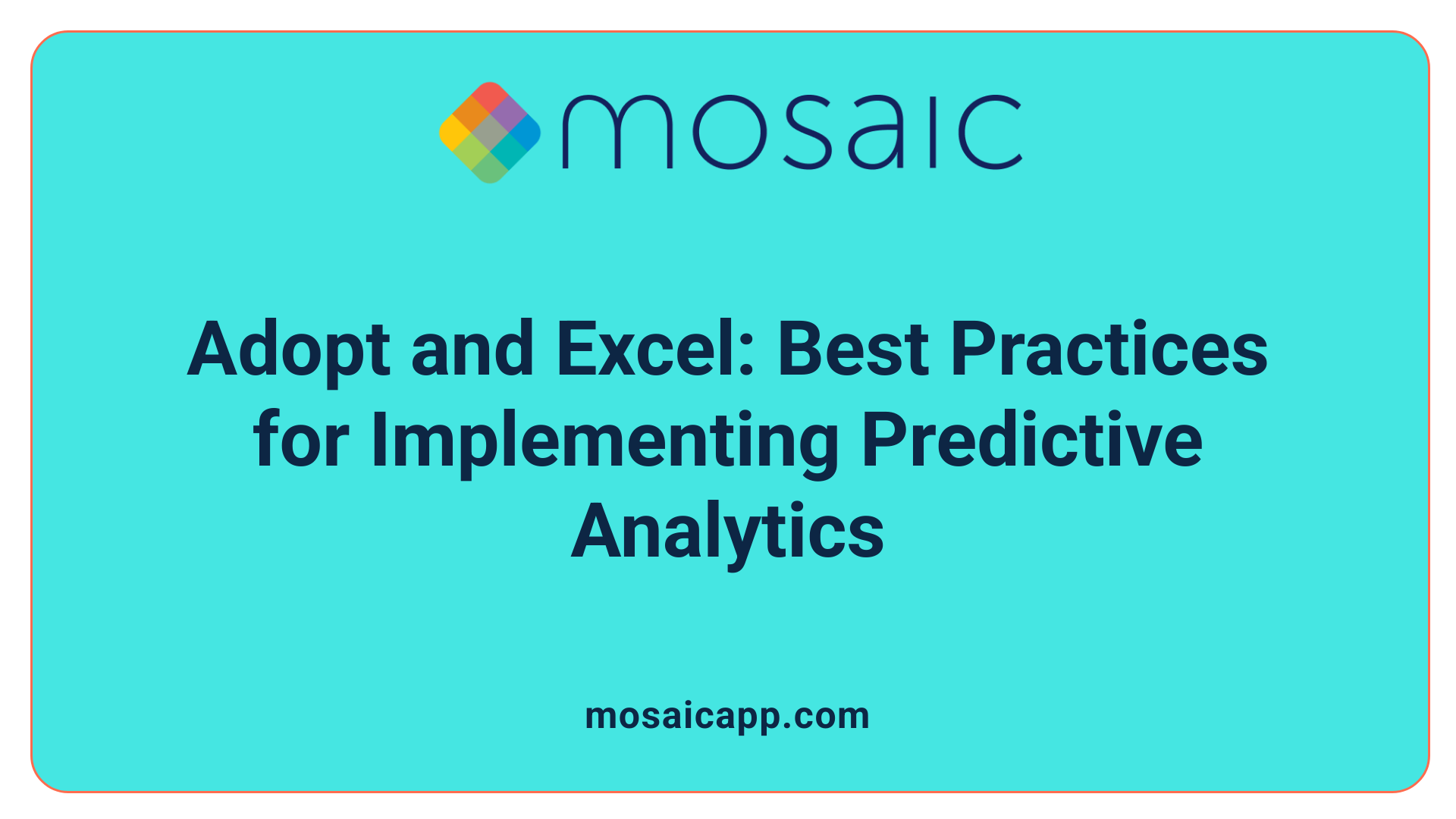Understanding the Power of Predictive Analytics in Modern Management
Predictive analytics has become a cornerstone of contemporary project and resource management, transforming how organizations plan, execute, and adapt to complex project environments. By leveraging historical data, advanced statistical algorithms, and machine learning techniques, organizations can forecast project outcomes with increased accuracy. This comprehensive approach supports proactive decision-making, enhances risk mitigation strategies, and optimizes resource utilization. As businesses face rapid changes and uncertainties, integrating predictive analytics into project workflows not only improves efficiency but also drives strategic advantages in competitive markets.
Foundations of Predictive Analytics in Project Management
 Predictive analytics in project management relies on a solid base of statistical algorithms, machine learning techniques, and thorough analysis of historical data.
Predictive analytics in project management relies on a solid base of statistical algorithms, machine learning techniques, and thorough analysis of historical data.
The statistical backbone involves probability theory, which helps quantify uncertainty in predictions, and statistical inference, allowing managers to draw meaningful conclusions from available data samples. This foundation enables the creation of models that can forecast project timelines, costs, and risks reliably.
Techniques such as regression analysis—both linear and logistic—are essential tools for understanding relationships between project variables. Regression models help estimate how changes in one factor might influence project outcomes, like delays or budget overruns.
Beyond regression, classification and clustering are used to identify patterns and categorize data. Classification models can, for example, flag risky projects or tasks, while clustering groups similar projects or resources to optimize planning.
Time series analysis is another crucial technique, allowing the prediction of future events based on past data trends. This is particularly useful for forecasting project progress or resource needs over time.
Machine learning algorithms augment these traditional statistical methods. Models such as decision trees, neural networks, and ensemble methods leverage statistical principles to enhance accuracy and adapt to complex project data.
Together, these statistical and machine learning methods form the core of predictive analytics in project management, providing a data-driven foundation for forecasting, risk assessment, and strategic decision-making.
Forecasting Project Outcomes and Identifying Risks

How does predictive analytics help in forecasting project timelines and identifying bottlenecks?
Predictive analytics relies on analyzing historical data, such as past project schedules, resource utilization, and delays, to create models that forecast future project timelines. Techniques like regression analysis and Monte Carlo simulations help identify potential delays and bottlenecks before they occur.
By examining patterns and trends, the models can predict when delays are likely to happen, allowing managers to take proactive measures. These forecasts are continually refined with real-time data throughout the project, providing dynamic insights that facilitate timely interventions.
In what ways can predictive analytics forecast budget overruns and resource shortages?
Predictive models analyze past financial data, including costs, expenses, and resource usage, to project future budget overruns. These tools can identify areas where expenses might exceed planned budgets, giving project managers the opportunity to recalibrate plans.
Similarly, by examining resource availability data and utilization rates, predictive analytics can forecast resource shortages. This enables better planning for labor, materials, and equipment needs, reducing downtime and avoiding project stalls.
How does predictive analytics improve risk management?
By analyzing both historical and current project data, predictive analytics identifies risk factors with potential major impacts—such as scope creep, technical failures, or weather delays. It assigns likelihoods and impacts to these risks, helping managers prioritize mitigation strategies.
Tools like classification models and scenario simulations allow teams to evaluate the effects of various risks under different conditions, promoting a proactive approach to risk mitigation.
What tools and techniques are commonly used for project outcome prediction?
Various platforms like IBM Watson, Google Cloud AI, and software like Excel are employed for predictive analytics in project management. Techniques such as regression analysis (linear and logistic), Monte Carlo simulations, neural networks, and decision trees are commonly applied to forecast project timelines, costs, and risks.
These models help forecast delays, budget overages, and resource shortages, providing actionable insights to optimize planning and execution.
| Application Area | Common Tools | Techniques | Benefit Highlights |
|---|---|---|---|
| Project Timelines | IBM Watson, Pecan AI | Regression, Time Series Models | Early delay detection, dynamic adjustments |
| Budget Overruns | Excel, Minitab | Regression, Monte Carlo | Cost risk prediction, contingency planning |
| Resource Shortages | Google Cloud AI | Machine Learning, Classification | Improved resource allocation, efficiency |
| Risk Factors | All above tools | Scenario Planning, Risk Modeling | Proactive risk mitigation |
Techniques and Models Powering Predictive Analytics

What methods and models are used in predictive analytics for project management?
Predictive analytics employs several advanced methods and models to forecast project outcomes and manage risks effectively. Among the most common techniques are regression analysis, Monte Carlo simulations, classification models, clustering models, and time series models.
Regression analysis, both linear and logistic, helps estimate project timelines, costs, and risks by analyzing relationships within historical data. Monte Carlo simulations utilize numerous randomized scenarios to assess the variability and uncertainty in project schedules and budgets, providing a probabilistic understanding of potential outcomes.
Classification models categorize data into predefined groups, which can be applied to identify project risks or classify project statuses. Clustering models group similar data points, aiding in market segmentation or identifying patterns in project performance.
Time series models analyze chronological data to forecast future project trends, such as resource demands or potential delays based on past performance data.
These models analyze large and complex datasets—collected through systems like Pecan AI, IBM Watson, or Oracle’s Crystal Ball—to generate precise predictions. Effective implementation involves systematic data collection, cleansing, and integration into project management workflows.
Training teams to understand and utilize these tools is crucial for seamless adoption. When used properly, these models allow project managers to anticipate issues early, optimize resource allocation, and make informed decisions that improve project success rates.
| Technique | Purpose | Example Applications |
|---|---|---|
| Regression Analysis | Estimating durations, costs, and risks | Predicting project delays and budgets |
| Monte Carlo Simulations | Handling uncertainty and variability | Forecasting schedule variability |
| Classification Models | Risk identification and categorization | Identifying high-risk projects or tasks |
| Clustering Models | Pattern recognition and grouping | Segmenting projects by performance traits |
| Time Series Analysis | Trend forecasting based on historical data | Anticipating resource needs over time |
By leveraging these techniques, organizations can foster proactive project management, ultimately leading to higher efficiency, reduced costs, and increased chances of project success.
Implementing Predictive Analytics in Project Workflows
Predictive analytics offers a powerful approach to improving project management by leveraging data-driven insights. To practically implement it into project workflows, organizations need to follow several systematic steps.
First, effective data collection is essential. This involves gathering high-quality historical and real-time data relevant to the project. Types of data include structured data from previous projects, unstructured reports, sensor data, and other contextual information such as weather or geospatial data where applicable. Accurate and comprehensive data forms the foundation for reliable predictions.
Next, developing suitable models is crucial. Teams can utilize various techniques like regression analysis to estimate timelines and budgets, Monte Carlo simulations for risk assessment, or machine learning algorithms for more complex pattern recognition. Popular tools such as IBM Watson, Minitab, Google Cloud AI, or even Excel can facilitate building these models. The choice depends on the project's complexity and available expertise.
Integrating predictive models into existing project management systems ensures continuous access to insights. This might involve connecting models to dashboards or project tracking tools, enabling real-time updates on potential delays, cost overruns, or resource shortages. Such integration helps project leaders detect issues early and respond proactively.
Finally, effective implementation depends on team training and ongoing model maintenance. Teams should be educated on interpreting model outputs accurately and understanding their implications for project decisions. Regularly updating models with new data and refining algorithms ensure sustained accuracy and relevance.
By following these practical steps—collecting quality data, developing appropriate models, integrating into workflows, and training teams—organizations can embed predictive analytics into their project management practices. This transformation fosters smarter resource allocation, proactive risk management, and ultimately, more successful project outcomes.
For further insights, exploring the search query "practical steps for integrating predictive analytics into project management" can provide detailed guides and case studies on this implementation process.
Best Practices for Successful Adoption

What are some best practices and industry insights for applying predictive analytics in projects?
Implementing predictive analytics successfully in project management requires careful planning and execution. One of the foundational steps is ensuring the quality of data. Using high-quality, cleansed, and comprehensive data sets—such as structured, unstructured, or time-series data—significantly enhances the accuracy of forecasts. Poor data quality can lead to unreliable predictions, which might misguide project decisions.
Choosing the right tools and models is equally important. Projects can leverage platforms like IBM Watson, Google Cloud AI, or simpler tools such as Excel, depending on complexity and resource availability. Selection should align with project goals, data types, and team expertise. Techniques such as regression analysis, Monte Carlo simulations, and machine learning algorithms like neural networks and decision trees are commonly employed to develop reliable predictive models.
Seamless integration into existing project management systems is vital. Embedding analytics into tools like Minute7 or real-time dashboards facilitates immediate access to insights, enabling proactive decision-making. For example, real-time data allows project leaders to quickly adjust timelines or reallocates resources based on forecasted bottlenecks or risks.
Engagement and training of stakeholders are essential. Project teams and decision-makers should understand how to interpret predictive outputs and incorporate them into their workflow. Regular training sessions and workshops help demystify data-driven insights and foster a culture of continuous improvement.
Ongoing monitoring and model refinement are crucial practices. As projects evolve, models need updates with fresh data to maintain accuracy. Regular evaluation helps identify drift or inaccuracies, ensuring predictive analytics remains a reliable tool.
Incorporating industry insights through scenario planning, simulations, and risk mitigation strategies enhances robustness. Using predictive models for scenario analysis helps anticipate potential issues like delays or budget overruns, facilitating proactive responses.
Overall, a systematic approach that emphasizes data quality, proper tool selection, stakeholder engagement, and continuous model evaluation fosters successful adoption. Staying informed about technological advancements and emerging best practices ensures that predictive analytics remains a strategic asset in project management.
Real-World Applications and Case Studies
Construction Delays
Predictive analytics plays a crucial role in construction project management by forecasting delays and potential bottlenecks. By analyzing historical data such as weather patterns, supply chain disruptions, and workforce availability, companies can proactively address issues before they escalate. For example, software tools using regression analysis and Monte Carlo simulations help project managers anticipate schedule overruns and adjust timelines accordingly.
Risk Management in Energy
In the energy sector, predictive analytics is used to quantify project risks, including equipment failure, environmental impacts, and market fluctuations. Advanced models analyze sensor data and transactional records to forecast potential problems, enabling energy firms to implement early mitigation strategies. These insights help ensure project reliability, optimize resource distribution, and minimize financial losses.
Healthcare Resource Optimization
Healthcare organizations utilize predictive analytics to forecast patient inflow and identify resource bottlenecks. Machine learning models analyze demographic data, health records, and seasonal trends to anticipate staffing needs, patient volume, and equipment utilization. This proactive approach enhances patient care quality, reduces wait times, and streamlines resource management.
Supply Chain Demand Forecasting
In supply chain logistics, predictive models forecast demand fluctuations based on historical sales, market conditions, and geospatial data. These forecasts facilitate smarter inventory management, demand planning, and scheduling, preventing stockouts or surplus inventory. Companies employ tools like IBM Watson and Excel combined with data mining and classification techniques to make accurate predictions.
| Industry Sector | Application Focus | Analytical Techniques Used | Example Outcome |
|---|---|---|---|
| Construction | Delay forecasting | Regression analysis, Monte Carlo simulation | Better scheduling, reduced overruns |
| Energy | Risk assessment | Sensor data analysis, predictive modeling | Improved project reliability, early failure detection |
| Healthcare | Resource optimization | Machine learning, demographic data analysis | Enhanced patient care, resource allocation optimization |
| Supply Chain | Demand prediction | Time series analysis, classification models | Reduced waste, improved inventory management |
Predictive analytics has demonstrated its ability to transform project efficiency and decision-making across industries. By effectively leveraging historical data and sophisticated algorithms, organizations are better equipped to anticipate risks, optimize resources, and achieve successful outcomes.
Future Trends and Innovations in Predictive Analytics
What are the future trends and innovations in predictive analytics for project resource management?
The landscape of predictive analytics in project management is evolving rapidly, driven by technological advancements and increasing data availability. One of the most notable future trends is the development of more advanced models that incorporate augmented analytics and automation. These sophisticated systems enable faster and more accurate decision-making by automatically analyzing large datasets and offering actionable insights.
Artificial intelligence (AI) and machine learning are set to become even more integrated into predictive analytics platforms. This integration will allow models to learn continuously from new data, refining their predictions over time and providing deeper, more nuanced understanding of project dynamics.
Real-time analytics will play a crucial role in future project management. With the proliferation of the Internet of Things (IoT), organizations can collect sensor data from various sources—such as machinery, environmental conditions, and project sites—and feed this data directly into analytics models. This setup facilitates immediate responses to project changes, delays, or risks, supporting more flexible and responsive management.
Tools leveraging AI-powered capacity planning and scenario analysis will increasingly enable organizations to optimize resource allocation proactively. By forecasting resource needs and identifying potential bottlenecks early, project managers can make smarter adjustments that prevent delays or shortages.
Additionally, hybrid approaches combining traditional project management with agile methodologies will benefit from these predictive capabilities. Emphasizing both strategic planning and adaptability, organizations will need to develop or enhance their digital and soft skills to effectively implement emerging technologies.
Overall, these innovations aim to automate more processes, foster strategic value creation, and enhance the overall responsiveness of projects. As a result, project teams will be better equipped to navigate the complexities of modern projects, ensuring higher success rates and more efficient resource use.
Embracing Data-Driven Strategies for Future Success
The integration of predictive analytics into project and resource management is revolutionizing the way organizations approach complex projects. By harnessing historical data, statistical modeling, and machine learning, businesses can forecast outcomes, identify risks, and optimize resources with unprecedented accuracy. This transition from reactive to proactive management allows for better decision-making, increased efficiency, and higher success rates. However, realizing these benefits depends on adopting best practices such as ensuring data quality, investing in appropriate tools, and fostering a culture of continuous learning. Looking ahead, technological advancements like AI, IoT, and augmented analytics promise even greater capabilities, enabling organizations to navigate the complexities of modern projects with confidence and agility. The future belongs to data-driven management — a strategic shift that will define project success in the years to come.
References
- Predictive Analytics in Project Management
- Integrating Predictive Analytics into Project Management ...
- How Project Management Excels With Predictive Analytics
- How Predictive Analytics Are Changing Project ...
- Implementing Predictive Analytics for Proactive Project ...
- Leveraging Predictive Analytics for Smarter Project Planning
- What is Predictive Analytics? | IBM


